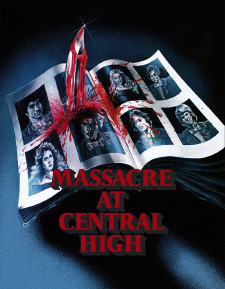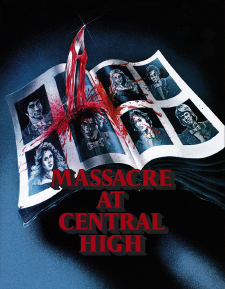Massacre at Central High (Steelbook) (Blu-ray Review)

Director
Rene DaalderRelease Date(s)
1976 (November 18, 2020)Studio(s)
Brian Distributing Corporation (Synapse Films)- Film/Program Grade: A-
- Video Grade: B+
- Audio Grade: B-
- Extras Grade: B+
Review
The late writer/director Renee Daalder's incendiary (literally) exploitation film cum political allegory Massacre at Central High flew under the radar in 1976, only to develop a well-deserved cult following a few years later. Like the best fables, its core themes are applicable regardless of era or cultural context. The production itself has certainly dated, but its message has not. Massacre at Central High starts out by setting the stage for a straightforward revenge drama. A group of four high school students control the rest of the student body through violence and intimidation, but when they push a new student too far, he turns the tables on them. Daalder could have left things at that and had a fairly simplistic antifascist parable, but his true intentions were far more complex.
Once the power structure at the school has been eviscerated, there’s a brief moment where the rest of the students form a relatively classless society, but it’s no proletarian utopia. Freed of oppression, some of the oppressed quickly become new oppressors of their own. Nature abhors an authoritarian vacuum. In her 1990 book Sexual Personae, Camille Paglia opined: “We are hierarchical animals. Sweep one hierarchy away, and another will take its place, perhaps less palatable than the first.” For Daalder, the only thing separating the oppressor from the oppressed is which one wields the power. The film is certainly antifascist, but Daalder rejects extremism from both sides.
As the hierarchies among the student body re-organize, the killer turns the tables yet again and starts to eliminate the new oppressors. His best friend asks him:
“Why? Those three guys, even me, okay. But why the others? What did they do to you?”
“Ah, that's not the point. See, it's what I did for them. When I came to that school, they weren't people; they were scared mice. They didn't have a chance. So I got rid of the guys keeping them down. But when they were on their own, they were as bad as the ones I'd killed. I couldn't bring them back, so to be fair I had to get rid of the others.”
The only thing that finally breaks the cycle is when two characters are willing to sacrifice themselves for the common good. Violent revolution perpetuates the systems that it attempts to overturn, but real reform only happens through a different kind of activism—one that’s willing to lay down power rather than seize it through force. Daalder’s revolutionary ideal is one that never seems to stop being radical, regardless of historical context: achieving moral power non-violently by consciously choosing physical powerlessness instead.
Massacre at Central High is almost surreal in the way that it creates a cloistered world for its teenage characters to inhabit. No teachers or other adults are visible for the majority of the running time. The police never appear until the closing shot, despite the increasingly absurd body count. In the absence of authority figures, the students develop a hierarchy of their own. The film has been compared to Lord of the Flies, and that comparison is valid in the sense that the teens are left to themselves to create their own sociopolitical structures. Central High is a Pirandellian institution that only exists as a stage for its characters. Adults remain unseen until a few are briefly glimpsed during an alumni dance at the finale, and it’s no accident that the only adults who appear in the entire film are actually former students of the same school. The never-ending cycle of political oppression and violence didn’t begin with the class of 1976, and it won’t end with them, either.
The struggle will always continue. Recent history has reinforced the fact that those who wish to sweep away hierarchies will end up replacing them with new ones. Anti-elitists always become new elitists of their own. Daalder's core message in Massacre at Central High is one that was quite relevant in 1976, but it’s only become more relevant in the decades since then.
Cinematographer Bertram van Munster shot Massacre at Central High on 35 mm film using Arriflex 35BL cameras with spherical lenses, framed at 1.85:1 for its theatrical release. According to Don May, Jr., Renee Daalder provided Synapse Films with a 1080p master based on his own restoration of the original elements, which had been re-framed at 1.78:1. There were plenty of problems with that version, but with no access to any other picture elements, they had to work with what they had been given. Essentially, they had to restore the restoration, and try to ameliorate issues created by misuse of digital tools. Synapse worked with three different restoration companies during the lengthy process, dropping the first two after they ended up creating even more issues.
Despite the challenges involved, the results are surprisingly good. Everything looks quite clean, with no visible signs of damage, but that wasn’t at the expense of detail. Fine textures such as the clothing show plenty of detail, especially the fuzzy sweaters worn by several cast members. The dupe elements used for the opening and closing credits naturally look softer, with coarser grain, but that’s unavoidable. (May says that there were issues with the closing credits that couldn’t be removed, but it’s nothing particularly distracting.) There are just a tiny number of dupe elements used in the body of the film, such as the shot starting at 36:16, which is the lead-in to a fade-out. Aside from those minor variances, the film looks as consistent as it can given the nature of what Synapse had to work with. Colors and contrast are both good. It’s all far from perfect, but this is hands-down the best that Massacre at Central High has ever looked on home video. It probably beats some of the prints that were in circulation in 1976.
Audio is offered in English 2.0 mono DTS-HD Master Audio, with optional English SDH subtitles. According to May, Daalder provided the audio files that they worked with, but the fidelity of those was unacceptably low, and there were missing sections as well. They ended up replacing those with a variety of sources, including a vintage VHS tape. Having to fix and equalize all of that means that the results are a bit less consistent than the restoration work done for the video. The overall fidelity is still noticeably low, and there’s a bit of excessive sibilance in some of the dialogue, but it’s all clear enough.
Interestingly, Daalder always hated the score by Tommy Leonetti that the producers added over his objections, especially the saccharine title song Crossroads. The song is indeed kitschy, but it provides a nicely ironic counterpoint to the montage of violent imagery from later in the film that plays behind the opening credits. It feels like the opening montage from a Mission: Impossible film directed by David Lynch.
Synapse’s Region-Free Limited Edition Blu-ray Steelbook release of Massacre at Central High is a two-disc set that includes a DVD copy of the film. It also includes a slipcover featuring the theatrical poster artwork for the film, and an eight-page booklet with an essay by Michael Gingold, as well as restoration notes from Don May, Jr. This edition has been limited to 4,000 units and it won’t be repressed, so if you want this version, grab it before it sells out. The following extras are included:
- The Projection Booth Podcast Interviews with Cast Members (87:00)
- Audio Interview with Director Renee Daalder (25:00)
- Hell in the Hallways (HD – 42:27)
- Original Theatrical Trailer (HD – 2:23)
- TV Spot (HD – :33)
- Radio Spot (HD – :27)
- Still Gallery (HD – 3:14)
Both of the interviews are encoded as alternate audio tracks, so they’re selectable from the audio menu rather than from the extras menu, and they need to be played along with the film. The first features Mike White from his The Projection Booth podcast, talking to actors Robert Carradine, Andrew Stevens, Rex Sikes, and Derrel Maury. The interviews were all conducted separately via telephone, so the audio quality varies a bit. This podcast runs the full length of the film, all the way through the end credits. The second track features a 2011 interview with Daalder, conducted by Fangoria writer Michael Gingold. Daalder passed away in 2019, so it’s an invaluable record of his thoughts about the film. For someone who subverted horror film tropes as thoroughly as he did, he was proud to have worked in the genre. His interview runs for approximately the first 25 minutes of the film, and then the normal audio resumes.
Hell in the Hallways is a new documentary about the making of Massacre at Central High, produced and directed by Michael Felsher via his Red Shirt Pictures. It includes interviews with surviving cast members Derrel Maury, Tom Logan, Rex Sikes, Robert Carradine, Andrew Stevens, and Jeffrey Winner, as well as crew members Bertram van Munster and first assistant director Eugene Mazzola. (Sadly, lead female cast members Lani O’Grady and Cheryl “Rainbeaux” Smith both died far too young from addiction-related issues, and Kimberley Beck was either unavailable, or unwilling to participate.) It’s a fairly comprehensive look at the production of the film from the perspectives of the interviewees, from casting to shooting, and it also covers the eventual cult status that the film achieved years after its original release. Everyone got along well, with Carradine describing the atmosphere as “party, party, party.” They discuss handling the film’s unique dialogue, and the challenges in shooting the stunts. (They’re also critical of the use of Crossroads in the final film, with Carradine lamenting the power of Daalder’s unused David’s Theme.) It’s a great collection of memories about the making of Massacre at Central High.
While there’s nothing unusual about exploitation films offering political allegories, Massacre at Central High remains a relatively unique example of one where the allegory is so powerful that it completely overwhelms the exploitation elements. Very few films have even tried to take up its mantle in the decades since 1976. That’s not to say that it hasn’t been influential, as it definitely affected writer Daniel Waters when he wrote Heathers. Ironically enough, Waters hadn’t even seen Massacre at Central High, but he had read about it in one of Danny Peary’s Cult Movies books. (That’s a sign of the indelible influence that Peary has had on generations of filmmakers and film fans like me.) The influence of Daalder’s film has been felt in ways both direct and indirect, but Massacre at Central High has a power all of its own that will never be duplicated.
- Stephen Bjork
(You can follow Stephen on social media at these links: Twitter and Facebook.)

